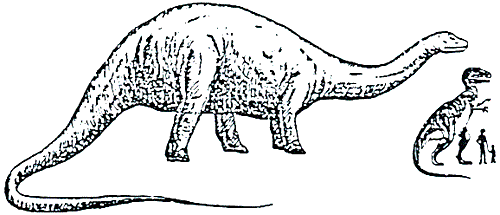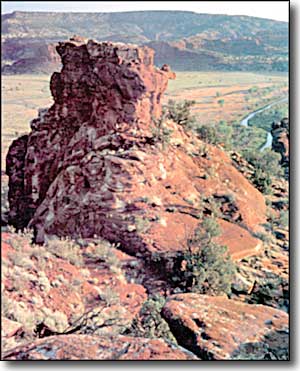
Dinosaur Lake-Picketwire Canyonlands
What The Tracks Say To Us


Tracks can tell us a lot of things, things like: how big the animal was, how many toes it had, was it four-footed or two-footed. With a trackway of consecutive footprints made by a single animal we can determine (through measurements) if the animal walked erect or semi-erect, the step length, what direction the animal was heading in and, with a simple formula, we can calculate the speed of trackmaker.
With trackways of several animals we can use the tracks as an informal census of the local populations: we can determine how many animals inhabited a particular region, how large or small or mixed they were, how random or organized (indicating herd or social group behavior) their movements were, and how common or rare particular types of dinosaur would have been at different points in time. And when we see tracks in several successive layers of strata, we get a timeline showing when particular animals appeared locally and when they disappeared, whether they increased or decreased in their time here, and how long they may have remained in the area. All of this gives us insight into the climatic and vegetative changes going on over these millions of years in southeastern Colorado.
When an animal steps in sand or mud, it leaves a track indicative of its' size, its' weight and the condition and consistency of the sediment being walked on. Tracks are usually found along shorelines and most of them run parallel to the shoreline trend. This is helpful in reconstructing the ancient geography of an area. In the Purgatoire Tracksite, many of the trackways trend westward along the shores of what we are now calling "Dinosaur Lake." Bones and other fossilized objects can get washed around and moved around for miles from their origination site but tracks never move, they are always found in their original position. By careful interpretation of the strata in which the tracks are found, we can greater understand the environment at the time the track was made. Sometimes the evidence says that a track was made after a flood, or while a lake was drying out between floods. Sometimes the evidence indicates the presence of an animal only in specific environments as indicated by the traces being found only in specific types of stone. When the environment changed, these animals left the area.
All the track-containing sedimentary layers of rock at the Purgatoire Tracksite indicate that this was a lake basin when these tracks were made. Alternating layers of tough, light grey limestone and soft, dark grey shale. The limestones are erosion resistant while the shales are easily weathered and crumbled, allowing the river to undercut the limestone beds and causing limestone slabs to collapse into the river.
The shales represent accumulations of mud in the ancient lake itself whereas the limestones represent accumulations of coarser, sand-textured sediments along the lake shore when water levels were low. The shales contain fossilized remains of algae, snails and tiny crustaceans known as "seed shrimp" and "clam shrimp." All of these species are common in quiet, shallow lakes. In contrast, the limestones contain impressions of large plant stems, dinosaur bones, trampled clams, scattered fish bones and lots of tracks. The limestones are also marked by ripple marks (caused by wave action) and by ooids (tiny, limey spheres) caused by wave action in shallow water.
This evidence supports the conclusion that the lake level fluctuated on a seasonal basis and also on longer term cycles covering decades and even centuries. The lake itself was probably 20 to 30 miles in diameter, shallow but with potable water most (if not all) of the time, and inhabited by a large variety of healthy flora and fauna of snails, algae, crustaceans and fish. The margins of the lake were partly or totally vegetated, the mud inhabited by clams and the whole area frequented by several types of dinosaurs. All in all, there's clear evidence of at least six times when dinosaurs visited this part of the shore of that ancient lake.
There are four track bearing layers of limestone at the Purgatoire Tracksite, bed #1 being the oldest. Track bed #1 shows abundant evidence of large brontosaurs and various smaller bipedal dinosaurs. The large amount of trampling evidenced by the hardened limey mud containing clams and primitive plants known as "horsetails" indicates that there was a lot of dinosaur activity going on at this time.
At the bottom of limestone bed #2 are deep footprints made before the limestone of bed #2 accumulated (and filled in the footprints). This suggests the trackmakers were wading in the shallow and muddy parts of the lake, perhaps at some distance from the shore.
The next two layers of track bearing material are at the top of bed #2: one at the very top and one just below the surface. The lower layer contains the tracks of small, bipedal carnivorous dinosaurs, and these tracks were clearly made before the top layers of limestone were deposited. The top layer of bed #2 is where most tracks are found at the Purgatoire Tracksite. Bed #2 is the hardest, most erosion resistant layer of limestone in the area and provides the most extensive surface available for study.
In the top of bed #3, a limestone layer containing fish remains and traces of plant roots, a few poorly preserved tracks have been found. Limestone bed #4 contains the remains of a sauropod skeleton that was heavily damaged by extensive trampling activity, activity so intense that only a few clear tracks are left. This much trampling suggests lots of dinosaur activity in the area at the time.
Because none of us humans were present at the time to see what was really going on, from this evidence all we can say is that on at least six different occasions, dinosaurs walked in the sand and mud that was here at that time. And on at least three of those six occasions, there were probably large numbers of dinosaurs present.
